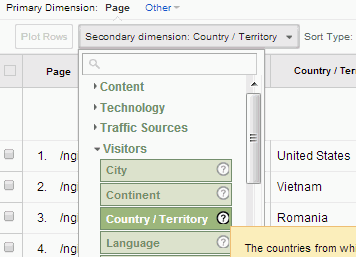Boost Your Information Evaluation with Secondary Dimension in Google Analytics
Boost Your Information Evaluation with Secondary Dimension in Google Analytics
Blog Article
Unlock Deeper Insights With Second Measurement in Google Analytics
With the huge area of data readily available in Google Analytics, the usage of second measurements can considerably improve your analytical capabilities. These additional layers of information use a nuanced point of view that can illuminate elaborate information within your key metrics. By strategically integrating secondary dimensions right into your evaluation, you can discover important insights that may otherwise remain obscure. The capability to dissect and analyze user habits with greater accuracy opens a realm of opportunities for optimizing strategies and boosting performance.
Understanding Primary Vs. Additional Measurements
When analyzing data in Google Analytics, it is important to identify between key and secondary measurements to obtain much deeper understandings into customer habits. Primary measurements are the primary groups by which you can watch your information, such as landing, source/medium, or tool web page. These measurements supply the fundamental framework for organizing and comprehending your information. On the various other hand, second measurements enable you to further study your key measurement information. By adding a second dimension, you can layer on additional information to your key measurement, allowing a more granular analysis. If your main dimension is the source/medium via which customers arrived on your website, including a secondary measurement like geographic area can reveal where those customers are located geographically. This added layer of details can assist you recognize patterns, patterns, or anomalies that may not have appeared when looking at the primary measurement alone. Leveraging both additional and key measurements in Google Analytics is vital for extensive data evaluation and notified decision-making.
Utilizing Additional Dimensions Effectively
Properly utilizing second dimensions in Google Analytics enhances the depth and granularity of data analysis, supplying useful understandings into customer habits and fads. By integrating second measurements together with primary dimensions, marketers and experts can delve deeper right into the specifics of individual interactions on their websites. Additional measurements allow users to sector and filter primary measurement information additionally, using a much more in-depth view of user habits, communications, and demographics. This can be particularly useful when trying to understand the influence of details variables on user interaction, such as the tools or web browsers they are utilizing, the sources of their web traffic, or their geographical locations.
Moreover, secondary dimensions allow individuals to contrast and contrast different data points within a solitary report, assisting in a more extensive evaluation of individual behavior patterns. By leveraging second dimensions efficiently, services can discover hidden understandings, optimize their advertising approaches, and improve the total user experience on their sites.
Discovering Typical Secondary Dimension Combinations
To even more examine user behavior and patterns in Google Analytics, it is important to explore typical mixes of second measurements. Some common secondary measurement mixes that provide important understandings consist of analyzing website traffic sources with individual places to understand where web site site visitors are coming from geographically and how they discovered the site. Checking out customer actions metrics with second measurements such as rate of interests or demographics can help in targeting specific target market sections extra successfully.
Using Secondary Dimension in Custom News
Using secondary dimensions in custom reports enables an extra comprehensive analysis of data in Google Analytics, enhancing the depth of insights acquired. When creating custom records in Google Analytics, integrating additional dimensions can provide an extra thorough sight of exactly how various measurements connect with each various other. This function allows users to dive much deeper into their information and uncover useful connections that might not be instantly obvious.
By using additional measurements in customized records, individuals can acquire a far better understanding of their web site or application website traffic. For instance, integrating the main dimension of "source/medium" with the second dimension of "touchdown page" can disclose which touchdown pages are doing finest for traffic originating from particular resources. This insight can help online marketers maximize their projects and boost total conversion rates.

Enhancing Data Visualization With Additional Dimension
When discovering data in Google Analytics customized records, including second measurements not just offers an extra thorough evaluation however additionally enhances the graph of insights with information visualization. By including a secondary dimension to your records, you can enrich the way information is presented, making it less complicated to determine patterns, patterns, and relationships within your site's efficiency metrics.
Second measurements can help you segment your information even more, enabling a much deeper understanding of customer habits and interactions on your site. This improved level of granularity can be particularly helpful when trying to separate details variables that might affect your site's performance - Secondary Dimension in Google Analytics.

Verdict
To conclude, leveraging additional dimensions in Google Analytics enables a more extensive analysis of data, bring about much deeper understandings and more educated decision-making. Secondary Dimension in Google Analytics. By including added layers of continue reading this information to key data collections, analysts and marketing experts can discover covert fads, patterns, and connections that offer a granular view of user habits and communications. This improved degree of understanding allows optimization of campaigns and customized techniques for particular target market sections, ultimately boosting efficiency and conversion rates
On the other hand, secondary dimensions enable you to more explore your key dimension information. By adding a secondary measurement, you can layer on extra info to your primary dimension, making it possible for a more granular analysis. If your primary dimension is the source/medium through which users showed up on your site, including an additional measurement like geographic location can disclose where those individuals are situated geographically. By integrating secondary measurements along with primary dimensions, online marketers and analysts can dive deeper into the specifics of customer interactions on their internet sites. Additional measurements enable individuals to section and filter key measurement information additionally, offering a more thorough straight from the source sight of user interactions, actions, and demographics.
Report this page